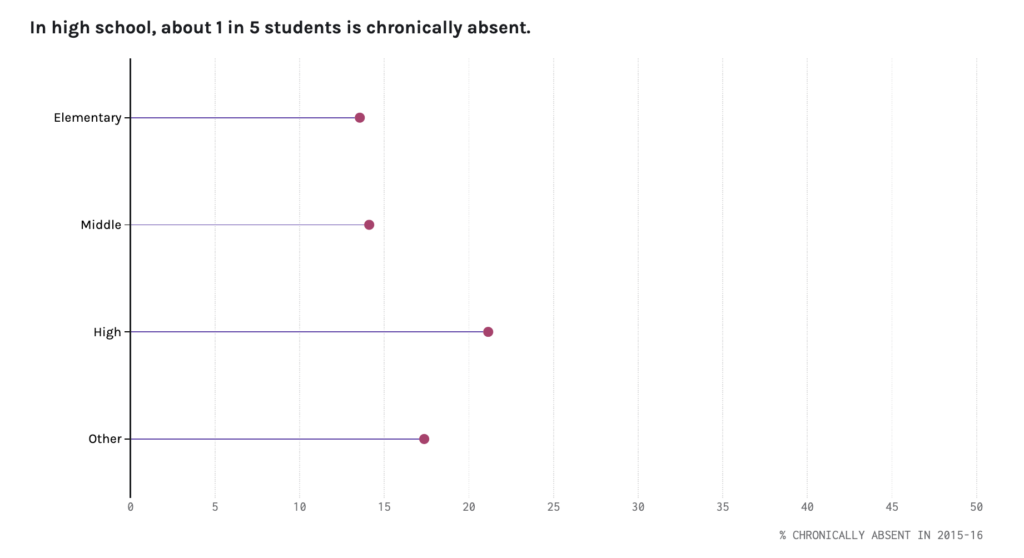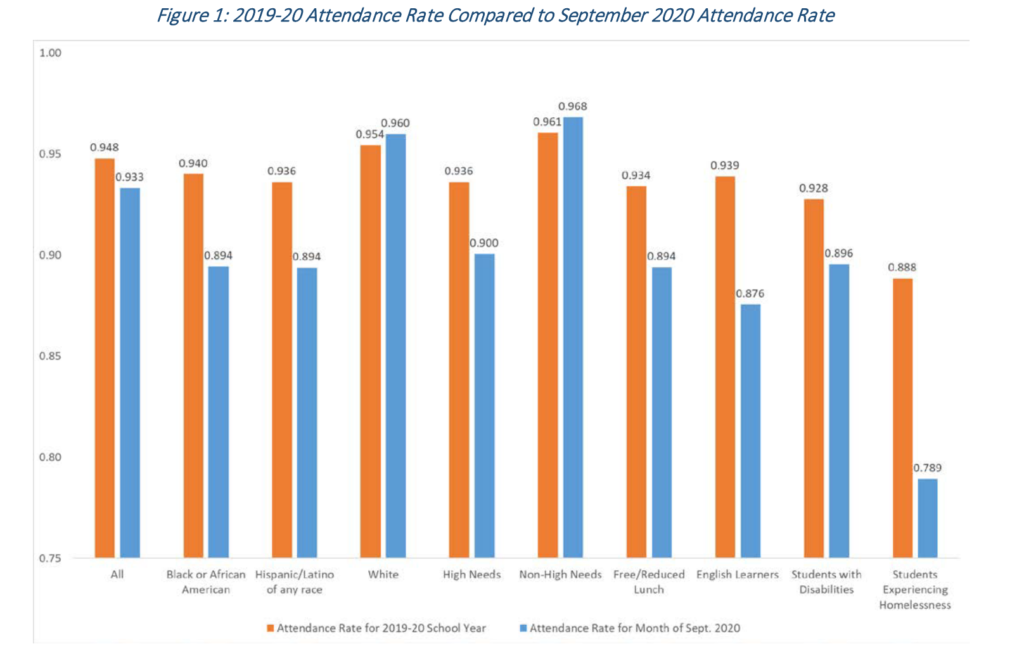

The coronavirus outbreak has compounded a serious problem within schools: chronic absenteeism. Chronic absenteeism is defined as a student missing two or more days of school per month – roughly 10% of their time in school. Amid the economic and health consequences of the coronavirus pandemic, educators have grappled with ensuring students’ return to school – whether classes are virtual or in person. Last spring, as thousands of schools subsequently closed their in-person classrooms and transitioned to virtual learning, millions of families and students suddenly faced the stressors of the pandemic (such as unemployment, lack of technology connectivity, and food and housing insecurity) that have disproportionately impacted low-income students of color and other vulnerable student populations. As students disappear from virtual classrooms because of lack of engagement, resources, or support, educators and policymakers must work to implement policies and practices that can reduce chronic absenteeism and strengthen the social and emotional aspects of learning.

Source: U.S. Department of Education. (2016). Chronic Absenteeism in the Nation’s Schools.
Distance learning has exposed the deep inequity in education as many students and families lack quality internet service and digital devices. Even before the pandemic, chronic absenteeism was a growing issue among students, with the U.S Department of Education reporting that in the 2015-16 school year nearly eight million students – about 16 percent of the nation’s public-school population – were chronically absent from school, with incredibly disproportionate numbers amongst Black and Brown students. Further, the state of California reported a 12 percent chronic absenteeism rate among students in 2018-2019, representing roughly 676,000 students missing from classrooms. The educational inequalities showcased the pandemic have only exacerbated an already deep-rooted issue. In November 2020, the Connecticut Department of Education released a report comparing current and pre-COVID attendance rates across subgroups (seen below), providing a glimpse into this issue at the state level.

Source: Connecticut State Department of Education (2020). Student Attendance in September 2020
It is no surprise that attendance is key to academic success, but chronic absenteeism has also been linked to social disengagement and feelings of alienation. Further, chronic absence, over the long-term, is found to be correlated with increased rates of high school dropout, negative health outcomes, and high poverty rates in adulthood. These risks, coupled with the consequences of the COVID-19 pandemic, have greatly impacted students from marginalized backgrounds – disproportionately affecting students of color, English Language learners, students with disabilities, and students from low-income communities. With early data from the 2020-21 school year revealing a sharp increase in the amount of time students are missing instruction, educators and policymakers alike must urgently and intentionally approach the rise of chronic absenteeism with a focus on equity.
Clearly Define Attendance and Collect Reliable Data | Attendance Works’ Examination of State Attendance Policies During the Covid-19 Pandemic found that the practice of taking daily attendance widely stopped as a result of school closures but has been reinstated in many, but not all, states for the 2020-21 school year. For those that do require attendance, state guidance proved inconsistent within and across states, making it difficult for stakeholders to clearly identify the problem. To most effectively tackle this issue, districts need clear guidance and the requisite data systems and tools to collect and analyze attendance data.
Investigate Early Warnings | School absences can occur early, even as early as the first week of school. Educators should pay attention to how much and which students miss class at the beginning of each term and use this data as an early indication to provide enhanced communication and additional outreach amongst these students and families.
Remove Access Barriers | The digital divide continues to be a major barrier for student attendance, especially as students continue to learn in a virtual setting. Apart from offering access to technology to prevent learning loss, schools should take steps to provide one-on-one support to students who lack internet or technical support. Some districts have employed “coaches” to collect attendance data, build relationships with students, and identify student specific barriers that may lead to attendance issues.
Expanded learning programs | Student learning can be supported through enrollment and participation in expanded learning programs – as research finds expanded learning programs significantly improve attendance during the day. During distance learning, expanded learning programs are providing new opportunities to achieve equity in school reopenings and recoveries.
Address Student Mental Health | Research indicates that chronic absenteeism is highly correlated with trauma. Educators should anticipate a greater need for mental health supports due to the stress and impacts on students and families throughout the coronavirus pandemic. The Planning for the Next Normal at School playbook suggests that educators consider the existing disparities and traumas faced by students and implement easy pathways for students to access mental health resources, such as regular classroom visits by mental health staff.
Rethink Attendance Accountability for Students | Traditionally, students who are chronically absent are referred to the criminal justice system. It is vital that pandemic-related absences are not subject to punitive and exclusionary practices that may funnel students into the juvenile justice system and disproportionately impact students from marginalized communities, without addressing the barriers to attendance. Instead, states and districts should adopt a positive, problem solving approach that seeks to address the root causes of absenteeism.